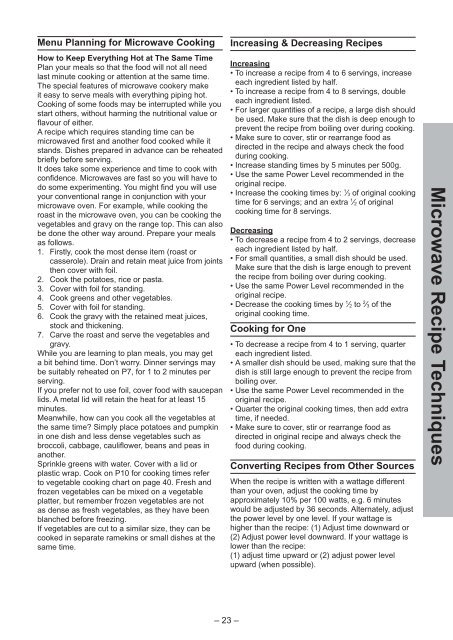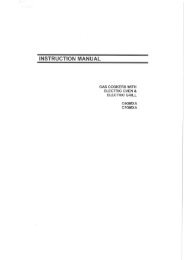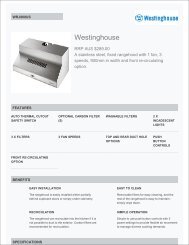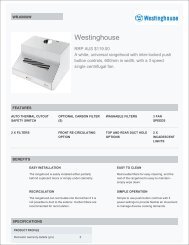Panasonic NN-ST671S 32Litre Microwave User Manual Download
Panasonic NN-ST671S 32Litre Microwave User Manual Download
Panasonic NN-ST671S 32Litre Microwave User Manual Download
You also want an ePaper? Increase the reach of your titles
YUMPU automatically turns print PDFs into web optimized ePapers that Google loves.
Menu Planning for <strong>Microwave</strong> Cooking<br />
How to Keep Everything Hot at The Same Time<br />
Plan your meals so that the food will not all need<br />
last minute cooking or attention at the same time.<br />
The special features of microwave cookery make<br />
it easy to serve meals with everything piping hot.<br />
Cooking of some foods may be interrupted while you<br />
start others, without harming the nutritional value or<br />
fl avour of either.<br />
A recipe which requires standing time can be<br />
microwaved fi rst and another food cooked while it<br />
stands. Dishes prepared in advance can be reheated<br />
briefl y before serving.<br />
It does take some experience and time to cook with<br />
confi dence. <strong>Microwave</strong>s are fast so you will have to<br />
do some experimenting. You might fi nd you will use<br />
your conventional range in conjunction with your<br />
microwave oven. For example, while cooking the<br />
roast in the microwave oven, you can be cooking the<br />
vegetables and gravy on the range top. This can also<br />
be done the other way around. Prepare your meals<br />
as follows.<br />
1. Firstly, cook the most dense item (roast or<br />
casserole). Drain and retain meat juice from joints<br />
then cover with foil.<br />
2. Cook the potatoes, rice or pasta.<br />
3. Cover with foil for standing.<br />
4. Cook greens and other vegetables.<br />
5. Cover with foil for standing.<br />
6. Cook the gravy with the retained meat juices,<br />
stock and thickening.<br />
7. Carve the roast and serve the vegetables and<br />
gravy.<br />
While you are learning to plan meals, you may get<br />
a bit behind time. Don’t worry. Dinner servings may<br />
be suitably reheated on P7, for 1 to 2 minutes per<br />
serving.<br />
If you prefer not to use foil, cover food with saucepan<br />
lids. A metal lid will retain the heat for at least 15<br />
minutes.<br />
Meanwhile, how can you cook all the vegetables at<br />
the same time? Simply place potatoes and pumpkin<br />
in one dish and less dense vegetables such as<br />
broccoli, cabbage, caulifl ower, beans and peas in<br />
another.<br />
Sprinkle greens with water. Cover with a lid or<br />
plastic wrap. Cook on P10 for cooking times refer<br />
to vegetable cooking chart on page 40. Fresh and<br />
frozen vegetables can be mixed on a vegetable<br />
platter, but remember frozen vegetables are not<br />
as dense as fresh vegetables, as they have been<br />
blanched before freezing.<br />
If vegetables are cut to a similar size, they can be<br />
cooked in separate ramekins or small dishes at the<br />
same time.<br />
Increasing & Decreasing Recipes<br />
Increasing<br />
• To increase a recipe from 4 to 6 servings, increase<br />
each ingredient listed by half.<br />
• To increase a recipe from 4 to 8 servings, double<br />
each ingredient listed.<br />
• For larger quantities of a recipe, a large dish should<br />
be used. Make sure that the dish is deep enough to<br />
prevent the recipe from boiling over during cooking.<br />
• Make sure to cover, stir or rearrange food as<br />
directed in the recipe and always check the food<br />
during cooking.<br />
• Increase standing times by 5 minutes per 500g.<br />
• Use the same Power Level recommended in the<br />
original recipe.<br />
• Increase the cooking times by: 1 ⁄3 of original cooking<br />
time for 6 servings; and an extra 1 ⁄2 of original<br />
cooking time for 8 servings.<br />
Decreasing<br />
• To decrease a recipe from 4 to 2 servings, decrease<br />
each ingredient listed by half.<br />
• For small quantities, a small dish should be used.<br />
Make sure that the dish is large enough to prevent<br />
the recipe from boiling over during cooking.<br />
• Use the same Power Level recommended in the<br />
original recipe.<br />
• Decrease the cooking times by 1 ⁄2 to 2 ⁄3 of the<br />
original cooking time.<br />
Cooking for One<br />
• To decrease a recipe from 4 to 1 serving, quarter<br />
each ingredient listed.<br />
• A smaller dish should be used, making sure that the<br />
dish is still large enough to prevent the recipe from<br />
boiling over.<br />
• Use the same Power Level recommended in the<br />
original recipe.<br />
• Quarter the original cooking times, then add extra<br />
time, if needed.<br />
• Make sure to cover, stir or rearrange food as<br />
directed in original recipe and always check the<br />
food during cooking.<br />
Converting Recipes from Other Sources<br />
When the recipe is written with a wattage different<br />
than your oven, adjust the cooking time by<br />
approximately 10% per 100 watts, e.g. 6 minutes<br />
would be adjusted by 36 seconds. Alternately, adjust<br />
the power level by one level. If your wattage is<br />
higher than the recipe: (1) Adjust time downward or<br />
(2) Adjust power level downward. If your wattage is<br />
lower than the recipe:<br />
(1) adjust time upward or (2) adjust power level<br />
upward (when possible).<br />
<strong>Microwave</strong> Recipe Techniques<br />
– 23 –

















